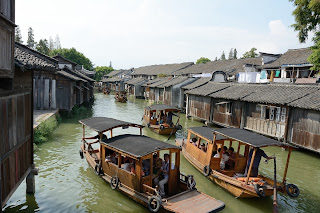During our stay in Shanghai we visited an ancient water town called Wuzhen. Wuzhen is about 135 km from Shanghai. We chose to take a tour bus from the Shanghai Tour Bus center. Figuring all that out was an experience in itself but, all-in-all, it went smoothly.
Wuzhen is one of the best examples of the old water towns in northern Zhejiang province. The town is about 1300 years old. It is located on the Grand Canal that takes water to Beijing and still serves as a transport artery in East China.
Notice the umbrellas on the bridge. It was pretty hot.
There are actually 2 sections of Wuzhen. These pictures are from the east section. In this section, residents still go about their business as thousands of tourists visit every day.
The west section is said to be quieter.
As you can see from the laundry, people live here. Walking along the street you can peer into the front rooms and see people watching TV, resting, etc. Many also have a cooler or cooking area for serving snacks or drinks to people as they walk by.
This part of Zhejiang is very flat and crisscrossed by canals.
The singled paddle boats cruise up and down the canal.
There are a number of museums in town. This is a picture from the Ancient Bed Museum. As the name suggests it contains a collection of Chinese beds. A lot of these beds are more like bed chambers.
The sleeping surface is either woven rope or wooden slats.
I'm not sure what the hanging fish is all about but it represents good luck.
This room is set up to celebrate a significant birthday. Probably a 60th birthday or 5th cycle of 12 zodiac years.
The purple banners are well known poems or couplets. There is a certain symmetry in the couplets.
There are a number of traditional workshops. This is a bucket shop. You can buy the hand made items if you desire.
In years past there were about 20 wine distilleries in Wuzhen. This is the last one. It is still operating and producing product. It dates to the 1360s.
The wine is called Sanbai or "three whites" wine. The 3 white ingredients are rice, wheat and "white" or pure water.
These are jars used to store the materials as they ferment.
Here are more of the fermentation jars. They produce products of 55%, 12% and 4% alcohol content.
This is the still.
Another traditional product is indigo dyed fabric. We didn't actually see the process area but this area is used for drying the fabric.
We did find the gift shop, though.
There is a wood carving museum, also. There were many fine examples of this ancient art.
Here Margot poses along one of the canals.
This women is making combs from cattle horns. You can see some of the raw material at her feet.
This woman is opening up silk cocoons to remove the worm before sending the silk on form processing.
Click to enlarge to get a look at the silk worms.
We had dinner at a restaurant about half way through the visit. Margot was asked if she would hold this child for a picture.
I should mention that Wuzhen is a very popular tourist destination but almost all the visitors are Chinese. We were among the very few westerners there. Living in a large international city like Beijing we forget that for many of the 1.35 billion people in China we are still a bit of a curiosity.
Those yellow items in the dish are ginko nuts, by the way.

The town is very interesting and pretty. I'd recommend it as a day trip from Shanghai.
I took this picture out the bus window. It looks like they are cubes of compressed scrap metal on the way to the recycle shop.
I thought it was interesting, anyway.




















No comments:
Post a Comment